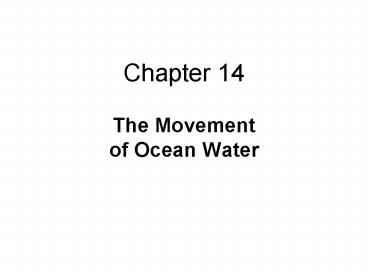The Movement of Ocean Water - PowerPoint PPT Presentation
1 / 33
Title:
The Movement of Ocean Water
Description:
Coriolis effect. Causes currents to move in clockwise direction. Continents deflect currents ... Coriolis Effect ... cause droughts if effect is prolonged for a ... – PowerPoint PPT presentation
Number of Views:2799
Avg rating:5.0/5.0
Title: The Movement of Ocean Water
1
Chapter 14
- The Movementof Ocean Water
2
Section 1 Currents
- Objectives
- Describe surface currents.
- List the three factors that control surface
currents. - Describe deep currents.
- Identify the three factors that form deep
currents.
3
Explore Currents
- Thor Heyerdahl
- Norwegian explorer
- Theory
- Inhabitants of Polynesia originally sailed from
Peru - Proved Theory in 1947 after spending 97 days at
sea and traveled more then 6,000 km
4
- What is Ocean Current?
- Surface current
- What is Surface Current?
- Affects only the upper few hundred meters of
seawater
5
Controlled by Three Factors
- Global winds
- Coriolis effect
- Causes currents to move in clockwise direction
- Continents deflect currents
6
(No Transcript)
7
Global Winds
- Near the equator,
- winds blow ocean water east to west
- At the poles
- ocean water is blown west to east
8
Coriolis Effect
- Apparent curving of the path of a moving object
from an otherwise straight path due to the
Earths rotation - Example Ball rolled from the center of a moving
merry-go-round
9
Continental Deflections
- Continents cover 1/3 of Earths surface
- When surface currents meet continents, the
currents deflect, or change direction.
10
Taking Temperatures
- Currents can affect the climate of an area
- West coast is cold (water comes from the north)
- East coast is warm (water comes from the south)
11
(No Transcript)
12
Deep Currents
- What are Deep Currents?
- Not directly controlled by wind
- Form in parts of the ocean where water density
increases - Density
- The amount of matter in a given space, or volume.
- Salinity
- Measure of the amount of dissolved salts or
solids in a liquid
13
(No Transcript)
14
Relationship b/w Surface Current and Deep Current
15
Section 2 Currents and Climate
- Objectives
- Explain how currents affect climate.
- Describe the effects of El Niño.
- Explain how scientists study and predict the
pattern of El Niño.
16
Warm-Water Currents and Climate
- Surface currents are generally much warmer than
deep currents - Temperatures of surface currents do vary
- Surface currents are classified as
- warm-water currents or coldwater currents
- Warm-water currents create warmer climates in
coastal areas that would otherwise be much
cooler.
17
Cold-Water Currents and Climate
- Cold-water currents also affect the climate of
the land near where they flow - Keeps the Coast climate cooler than the inland
climate year round
18
Upwelling
- Process in which cold, nutrient-rich water from
the deep ocean rises to the surface and replaces
warm surface water - Occurs when cold water from deep in the ocean
rises to the surface in an area - Area of good nutrients and good fishing
- Process in which cold, nutrient-rich water from
the deep ocean rises to the surface and replaces
warm surface water
19
(No Transcript)
20
Surface Currents and Climate
- El Niño
- Periodic change in the location of warm and cool
surface waters in the Pacific Ocean - Can last for a year or longer
- Changes the interaction of the ocean and the
atmosphere - Which in turn changes global weather patterns.
- La Niña
- periodic change in the eastern Pacific Ocean in
which the surface-water temperature becomes
unusually cool. - Like El Niño, La Niña also affects weather
patterns.
21
Effects of El Niño
- Causes more then average rainfall on the Western
edge of the Pacific Ocean - Can cause mudslides and flashfloods
- Causes less then average rainfall on the Easter
edge of the Pacific Ocean - Can cause droughts if effect is prolonged for a
long period of time - Upwelling of nutrient-rich water does not occur
off the coast of South America, - Affects the organisms that depend on the
nutrients for food.
22
Studying and Predicting El Niño
- Occurs every 2 to 12 years,
- Data collected through a network of buoys
operated by the National Oceanic and Atmospheric
Administration (NOAA)
23
Section 3
- Waves movements in which water alternately rises
and falls - Crest highest point
- Trough lowest point
24
(No Transcript)
25
- Wave Height distance between crest and trough
- Wavelength distance between crest to crest
26
(No Transcript)
27
- Energy moves forward while water particles remain
in the same place
28
- Breaker when the top of waves move faster than
the bottoms, tall enough waves collapse
29
- The height of waves depends on
- 1) wind speed
- 2) distance wind blows
- 3) time of blowing
30
(No Transcript)
31
- Tides long waves that result in a periodic
change in the surface level of the oceans due to
the gravitational pull of the moon
32
- Tidal range difference between high and low tide
33
(No Transcript)































